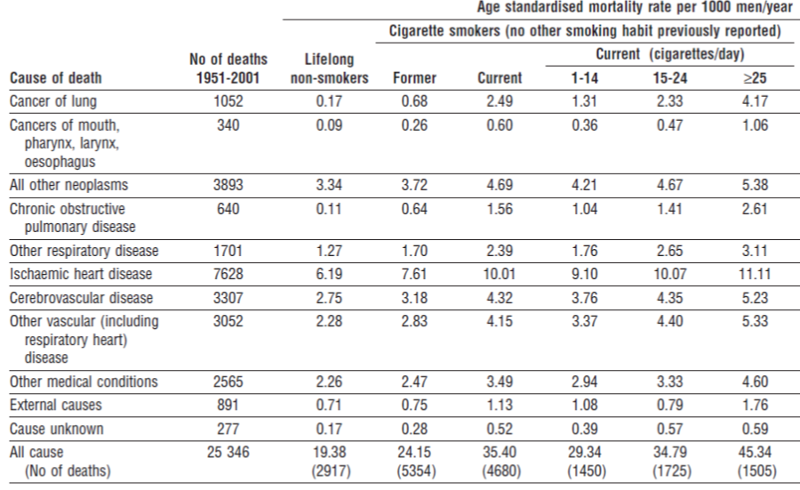The Evidence
Enstrom and Kabat
Environmental tobacco smoke and tobacco related mortality in a prospective study of Californians, 1960-98.
(Enstrom JE and Kabat GC. British Medical Journal. 2003;326:1057-1066.)
Read this paper, and consider your answers to the following questions:
- What type of study design is this? What are the strengths and weaknesses of this study design?
- What was the primary exposure of interest, and how was the level of exposure estimated? Was the assessment of exposure adequate?
- What were the primary outcomes of interest, and how was outcome status evaluated? Was the outcome status adequately evaluated?
- What do these results suggest regarding the association between active smoking and risk of heart disease, lung cancer, and chronic pulmonary disease?
- What do these results suggest regarding the association between passive smoking (i.e., ETS) and risk of heart disease, lung cancer, and chronic pulmonary disease?
- What conclusions did the authors reach?
- Could the validity of their conclusions have been undermined by random error? How did they assess random error? Was the sample size adequate, i.e., did the study have sufficient statistical power to address the primary goals of the study? (Resources: Measures of Association, Random Error, Confidence Intervals, and Sample Size and Power)
- Could the validity of their conclusions have been undermined by any biases? (Resources: Bias.)
- Did the authors adequately evaluate the possibility that confounding undermined the validity of their conclusions? (Resources: Confounding and Multivariable Methods)
- Did the authors have any vested interests that might have interfered with their objectivity?
- After your critical reading of the paper, do you believe that the conclusions are valid?
See also Responding to the Enstrom and Kabat study on secondhand smoke by the American Non-smokers Rights Foundation.
Doll, Peto, et al.
The data in the table below are from Doll R, Peto R, Boreham J, and Sutherland I: Mortality from cancer in relation to smoking: 50 years observations on British doctors. British Journal of Cancer 2005;92:426–429.

The table lists mortality rates per 1,000 men for never smokers, former smokers, and a range of current smokers. Consider the following exposure averages:
- 1-14 means 10 cigarettes per day,
- 15-24 means 20 cigarettes per day, and
- > 25 means 30 cigarettes per day,
- and lifelong non-smokers smoked 0 cigarettes per day.
Using the average exposures for smokers listed above, use Epi Tools to perform a simple linear regression examining the relationship between smoking and incidence of mortality from ischemic heart disease per 1000 men per year.
Assuming that the relationship is linear, how much does the risk of ischemic heart disease increase for each additional cigarette smoked per day on average [Hint]?
Rosenlund, Berglind, et al.
Environmental Tobacco Smoke and Myocardial Infarction among Never-Smokers in the Stockholm Heart Epidemiology Program (SHEEP). (Rosenlund M, Berglind N, et al. Epidemiology. 2001;12(5):558-564.)
Read this paper, and consider your answers to the following questions:
- What type of study design is this? What are the strengths and weaknesses of this study design?
- What was the primary exposure of interest, and how was the level of exposure estimated? Was the assessment of exposure adequate?
- What were the primary outcomes of interest, and how was outcome status evaluated? Was the outcome status adequately evaluated?
- What do these results suggest regarding the association between passive smoking (i.e., ETS) and risk of heart disease?
- What conclusions did the authors reach?
- Could the validity of their conclusions have been undermined by random error? How did they assess random error? Was the sample size adequate, i.e., did the study have sufficient statistical power to address the primary goals of the study? (Resources: Measures of Association, Random Error, Confidence Intervals, and Sample Size and Power)
- Could the validity of their conclusions have been undermined by any biases? (Resources: Bias.)
- Did the authors adequately evaluate the possibility that confounding undermined the validity of their conclusions? (Resources: Confounding and Multivariable Methods)
- Did the authors have any vested interests that might have interfered with their objectivity?
- After your critical reading of the paper, do you believe that the conclusions are valid?
Even when an outcome is uncommon, valid associations can be very important in a large population. Another way of testing for potentially important associations when the outcome is rare is to conduct a meta-analysis, in which the results of a number of smaller studies are pooled. It is possible that individual studies may have very limited statistical power because of limited sample size. However, by pooling the results of many similar studies, it may be possible to detect small, but important association.
Read the following meta-analysis by He et al.:
- Passive Smoking and the Risk of Coronary Heart Disease — A Meta-Analysis of Epidemiologic Studies.
(He J, Vupputuri S, et al. N Engl J Med. 1999;340:920-926
Gilliland et al.
Environmental Tobacco Smoke and Absenteeism Related to Respiratory Illness in Schoolchildren.
(Gilliland FD, Berhane K, et al. Am. J. Epidemiology. 2003;157(10):861-869.)
Read the article and consider the following questions.
- What type of study design is this? What are the strengths and weaknesses of this study design?
- What was the primary exposure of interest, and how was the level of exposure estimated? Was the assessment of exposure adequate?
- What were the primary outcomes of interest, and how was outcome status evaluated? Was the outcome status adequately evaluated?
- What do these results suggest regarding the association between passive smoking (i.e., ETS) and risk of heart disease?
- What conclusions did the authors reach?
- Could the validity of their conclusions have been undermined by random error? How did they assess random error? Was the sample size adequate, i.e., did the study have sufficient statistical power to address the primary goals of the study? (Resources: Measures of Association, Random Error, Confidence Intervals, and Sample Size and Power)
- Could the validity of their conclusions have been undermined by any biases? (Resources: Bias)
- Did the authors adequately evaluate the possibility that confounding undermined the validity of their conclusions? (Resources: Confounding and Multivariable Methods)
- Did the authors have any vested interests that might have interfered with their objectivity?
- After your critical reading of the paper, do you believe that the conclusions are valid?
- Are these findings relevant to the dispute between Galila Huff and her neighbors? Are these findings relevant to the question of whether acute exposure to secondhand tobacco smoke can produce acute myocardial infarction?

